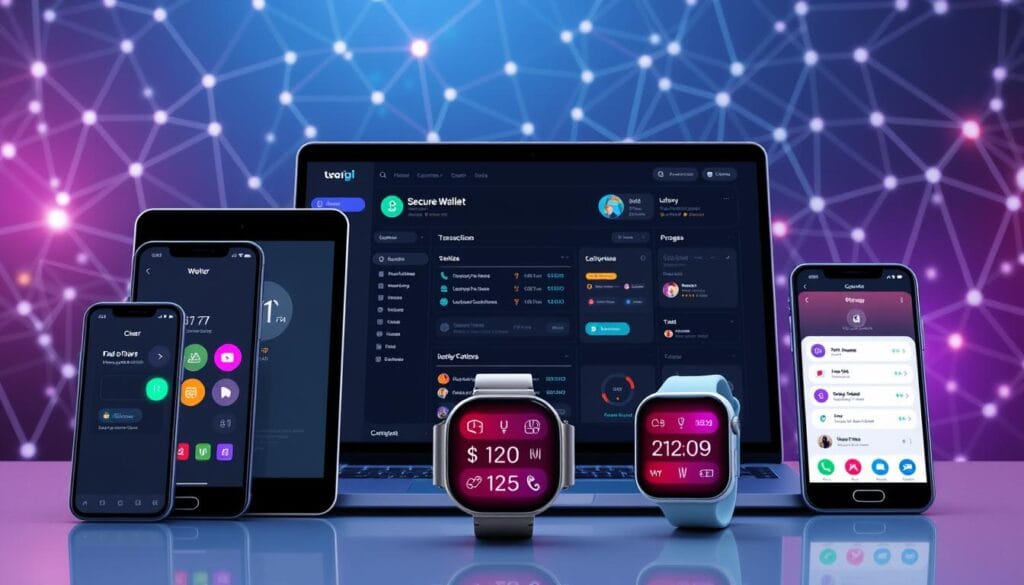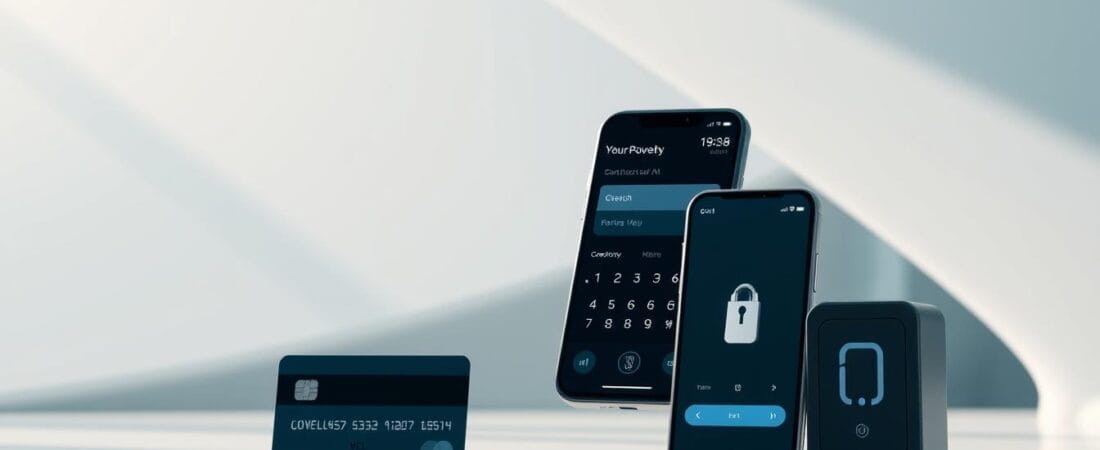The global mobile wallet market is projected to double by 2025 compared to 2020, signaling a seismic shift in how people handle transactions. In the U.S., 89% of consumers used cashless methods in 2022, with two-thirds expecting to adopt these tools within two years. This trend highlights the growing reliance on technology for everyday financial needs.
As the demand for seamless and secure solutions rises, choosing the right tool becomes critical. This article explores the top contenders for 2025, including Apple Pay and Cash App, while addressing key concerns like compatibility and feature selection. Whether you’re a tech enthusiast or a professional, this guide will help you navigate the evolving landscape of financial technology.
Key Takeaways
- The global mobile wallet market is expected to double by 2025.
- 89% of Americans used cashless methods in 2022.
- Two-thirds of U.S. consumers plan to adopt these tools soon.
- Security and compatibility are top concerns for users.
- This guide highlights top options like Apple Pay and Cash App.
What Are Digital Wallets and How Do They Work?

With the rise of cashless systems, virtual payment tools are becoming essential. These tools act as encrypted containers for storing payment credentials and transactional data. They integrate seamlessly with bank accounts and cards, making it easy to manage finances.
One of the core features is the ability to link bank accounts or cards. This process allows users to make non-cash transactions, transfer funds, and even withdraw money at ATMs. However, virtual-only tools often have limitations when it comes to cash withdrawals.
Transactions are facilitated through technologies like NFC and QR codes. NFC works within a 4-20cm range, enabling quick contactless payments. QR codes, on the other hand, require scanning but are widely used in retail and online platforms.
Security is a top priority. Unlike static card numbers, these tools use tokenization to generate dynamic transaction IDs. This process randomizes data, reducing the risk of fraud. Encryption further ensures that sensitive information remains protected.
These systems are designed for convenience and safety. Whether you’re paying at a store or transferring money online, they offer a streamlined experience. As technology evolves, their role in everyday transactions will only grow.
Why Digital Wallets Are the Future of Payments

Modern payment methods are evolving rapidly, driven by consumer demand for simplicity and safety. The pandemic accelerated the adoption of contactless systems, with 65 million Venmo users showcasing the rise of peer-to-peer transactions. This shift reflects a lasting behavioral change, as more people prioritize seamless and secure solutions.
Walmart Pay’s QR-based system is a prime example of innovation bridging gaps. It allows users without NFC-enabled devices to enjoy the benefits of cashless transactions. This approach ensures inclusivity, making virtual payment tools accessible to a broader audience.
Superapps like WeChat and Grab are redefining the landscape by merging payments with lifestyle services. These platforms offer everything from food delivery to ride-hailing, creating a one-stop solution for users. This integration highlights the growing importance of convenience in modern financial tools.
Younger generations, particularly Gen Z and Millennials, are leading the charge in app-based financial management. They prefer tools that offer transparency, ease of use, and robust security. This trend is shaping the future of banking, pushing institutions to adapt to consumer expectations.
Starbucks’ loyalty program is another success story, demonstrating how retail adoption can drive widespread use. By combining rewards with payment functionality, it creates a compelling value proposition for users. This model is likely to inspire further innovation in the industry.
As these trends continue, virtual payment systems will play an increasingly central role in everyday transactions. For more insights on financial technology, explore decentralized lending platforms and their impact on the financial landscape.
Types of Digital Wallets to Suit Your Needs
![]()
The variety of virtual payment tools available today caters to diverse user needs and preferences. From mobile-based solutions to crypto storage, there’s a tool for every transaction style. Understanding the differences can help you choose the right option for your financial habits.
Mobile Wallets
Mobile wallets require NFC-enabled smartphones like iPhones or Android devices for in-store tap-to-pay. These tools use Secure Element chips to encrypt card data, ensuring security during transactions. Apple Pay is a prime example, offering seamless integration with devices.
Online Wallets
Online wallets, such as PayPal, enable browser-based checkouts for e-commerce. Features like PayPal One Touch streamline the process, while tokenization replaces card numbers to enhance safety. These tools are ideal for frequent online shoppers.
Contactless Payment Cards
Contactless cards from Visa or Mastercard mimic wallet functionality without requiring a smartphone. Embedded NFC chips allow for quick payments at physical retail locations. This option is perfect for those who prefer using debit cards over apps.
Cryptocurrency Wallets
Crypto wallets come in two forms: hot wallets like Skrill and cold storage hardware. Hot wallets are integrated into platforms, while cold storage offers offline security. Regulatory developments may impact their usability by 2025. For more insights, explore top secure cryptocurrency wallets.
Peer-to-Peer (P2P) Wallets
P2P wallets like Venmo and Cash App focus on instant transfers. Venmo’s social feed adds a unique touch, while Cash App allows Bitcoin trading. Zelle’s bank-backed infrastructure ensures reliability for peer transactions.
Key Benefits of Using Digital Wallets

Financial technology is reshaping the way consumers interact with their money. Virtual payment solutions offer unparalleled security, reducing fraud by 73% compared to physical cards. Encryption and tokenization provide dual layers of protection, ensuring sensitive data remains safe during transactions.
These tools also deliver unmatched convenience. Users can manage loyalty cards, tickets, and ID documents in one place. The Starbucks app is a prime example, combining payments with rewards redemption for a seamless experience.
When it comes to payment options, platforms like PayPal offer cross-border functionality, while others like Cash App have regional limitations. This flexibility makes it easier to handle international transactions. Additionally, integrating with bank accounts ensures smooth fund transfers and withdrawals.
Biometric authentication, such as fingerprint or facial recognition, adds another layer of security. Zelle’s $250,000 fraud protection further reassures users of their financial safety. These features make virtual payment tools a reliable choice for modern consumers.
Finally, the environmental impact cannot be ignored. By reducing the need for plastic card production, these solutions contribute to a greener future. For more insights on financial technology, explore innovative solutions that are transforming the industry.
Digital Wallets for Secure Payments: What You Need to Know

As financial transactions evolve, understanding the security behind modern payment tools is crucial. Providers must adhere to PCI DSS compliance, ensuring sensitive data is protected during transactions. This standard is a cornerstone of trust in the industry.
Biometric authentication is becoming a standard feature, with 85% of new smartphones expected to support it by 2025. Fingerprint and facial recognition add an extra layer of protection, making unauthorized access nearly impossible.
Chargeback rights vary significantly between platforms. PayPal offers robust consumer protections, while cryptocurrency transactions are often irreversible. Understanding these differences is essential for informed decision-making.
Despite advanced technical safeguards, social engineering remains a risk. Users must stay vigilant against phishing and scams. Education is the first line of defense in these scenarios.
When evaluating payment tools, check for certifications like FCA regulation or Samsung Knox’s defense-grade security. These ensure compliance and reliability. For more insights, explore how to enhance transaction security with blockchain technology.
Whether you’re using debit or credit options, prioritizing encryption and compliance ensures a safer financial experience. Always verify the credentials of your chosen platform to protect your assets.
Top Digital Wallets to Watch in 2025

The financial landscape is rapidly evolving, with innovative tools reshaping how we manage transactions. As we look ahead to 2025, several platforms stand out for their advanced features and growing adoption. These tools not only simplify payments but also enhance security and convenience.
Apple Pay
Apple Pay continues to lead with its Secure Element technology, which encrypts sensitive data for enhanced protection. Its integration with Ultra-Wideband (UWB) enables precise location payments, reducing the risk of fraud. Additionally, Apple Pay is expanding its transit network integrations, now supporting over 15,000 systems globally.
Google Pay
Google Pay leverages cloud-based Host Card Emulation (HCE) for seamless transactions. Its integration with Gmail allows users to pay invoices directly from their email, streamlining the process. The platform’s success in India’s Unified Payments Interface (UPI) serves as a blueprint for global growth.
Samsung Pay
Samsung Pay stands out with its Magnetic Secure Transmission (MST) technology, which supports legacy payment terminals. Its Knox Vault hardware isolation ensures sensitive data remains secure. While focusing on NFC for future-proofing, Samsung Pay maintains compatibility with older systems.
PayPal
PayPal’s One Touch feature significantly improves conversion rates by simplifying the checkout process. Its integration with Buy Now, Pay Later (BNPL) services has also boosted average order values. For more insights, explore top digital wallets and their unique features.
Cash App
Cash App is making waves in the cryptocurrency space, with its Bitcoin volume surpassing Coinbase. The adoption of the Lightning Network has reduced transaction costs, making Bitcoin trading more accessible. Additionally, its stock trading features are attracting a younger, tech-savvy audience.
How to Choose the Right Digital Wallet for You
Selecting the right financial tool requires understanding your unique needs and preferences. With platforms like Skrill supporting over 25 currencies and Dwolla focusing on ACH transfers, the choice depends on your payment options and usage patterns.
For frequent travelers, multi-currency support is essential. Domestic users, on the other hand, may prioritize speed and simplicity. Venmo’s social features appeal to those who value connectivity, while Zelle’s bank-backed infrastructure ensures rapid transfers.
Compatibility with your devices is another critical factor. For example, Apple Pay requires an iPhone 10 or newer. Always check if your smartphone supports the platform’s features to avoid compatibility issues.
Hidden fees can also impact your decision. Foreign transaction charges and instant transfer premiums vary widely between platforms. Skrill’s tiered verification process highlights the importance of understanding account requirements, especially for business users.
Emerging trends like CBDC support and AI-driven fraud detection are shaping the future of financial tools. Staying informed about these developments ensures you choose a platform that aligns with your long-term goals. For more insights, explore how to track your expenses smartly with AI-powered.
By evaluating your habits and priorities, you can find a solution that offers the right balance of security, convenience, and functionality. Whether you’re a crypto enthusiast or a traditionalist, the right method is out there.
Emerging Trends in Digital Wallets for 2025
The future of financial transactions is being reshaped by innovative technologies and user-centric solutions. As we approach 2025, the market for payment tools is expanding, driven by advancements in cryptocurrency and contactless payment systems.
One notable trend is the integration of Central Bank Digital Currencies (CBDCs). Pilots like the FedNow Service are exploring compatibility with existing systems, aiming to enhance financial inclusion. This shift could redefine the range of services offered by financial tools.
Wearable technology is also gaining traction. Major banks are introducing smart rings that enable seamless transactions. This innovation aligns with the growing demand for convenience and accessibility in the digital wallet space.
AI-powered predictive spending analytics are becoming a standard feature. These tools analyze user behavior to provide insights, helping individuals manage their finances more effectively. This trend highlights the role of technology in personal financial management.
Sustainability is another focus area. Platforms are introducing features like carbon footprint tracking per transaction. This initiative reflects the industry’s commitment to environmental responsibility.
Decentralized identity verification, leveraging blockchain, is set to enhance security. This approach ensures that user data remains protected while simplifying the authentication process. For more insights on these trends, explore key trends and insights in the financial technology space.
“The integration of AI and blockchain is transforming how we think about financial security and convenience.”
As these trends evolve, they will shape the future of financial tools, making them more versatile and user-friendly. Staying informed about these developments is crucial for anyone looking to leverage the latest innovations in the industry.
Conclusion
As the financial landscape evolves, choosing the right payment solution becomes essential for consumers. Biometric authentication and cross-platform interoperability are key differentiators for 2025. These features ensure both convenience and security, making them critical for modern financial tools.
Selecting platforms with upgradable encryption protocols is vital. This ensures long-term protection against emerging threats. The battle for dominance between Big Tech and banking apps will likely intensify, driving innovation in the sector.
For added safety, consider layering your digital wallets with credit monitoring services. This extra step provides an additional layer of protection. Staying updated on regulatory changes is also crucial to ensure compliance and security.
For more insights on how these tools are transforming the financial landscape, explore this comprehensive guide. Making informed choices today will prepare you for the future of financial transactions.

